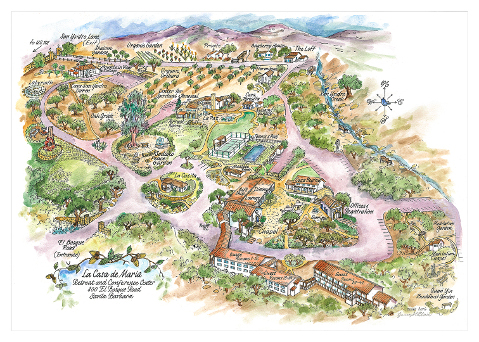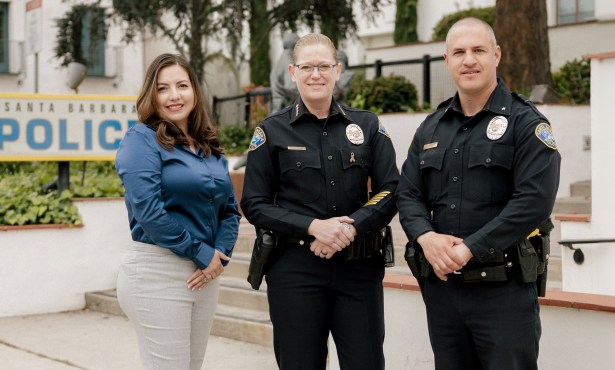La Casa de Maria, an Island of Serenity
For Catholic Couples at First, Now a Retreat for All Faiths
High in the Montecito hills, off of El Bosque Road, sits La Casa de Maria, an island of serenity and calm in an increasingly fast-paced world. This former citrus ranch is today a retreat and conference center offering a variety of programs for those of troubled mind and spirit.
In 1886, Richard Hoge of Montana purchased 20 acres from the owners of the San Ysidro Ranch for a lemon ranch, which he christened El Prado (The Meadow). Here he farmed successfully before selling to E. J. Miley in 1924, a building contractor who also made a sizeable fortune in Kern County oil. Miley engaged Mary Craig to design a new home for his Rancho El Bosque. Among her many Santa Barbara commissions, perhaps her best known is Plaza Rubio, the small subdivision facing the Mission Rose Garden.

Construction proceeded slowly, for Miley wanted the house made of hand-hewn stone drawn from the local creeks. Miley also imported stone and tile from various European sources to enhance his showcase. The onset of the Great Depression in 1929 dealt Miley’s fortunes a severe blow, and, in 1932 he was forced to sell the partially finished house to John and Ethel de Blois Wack.
Wack was a successful Wall Street investor and an avid horseman and aviator. As a young man he had been an editor for Field and Stream magazine, which his father cofounded. Ethel, whom he married in 1923, was a respected portrait painter, champion golfer, and also an aviator. The couple flew their plane all over North America, often checking on their Arizona cattle operation.
Working with architect Chester Carjola, the Wacks completed the house in 1933, and several other structures were later added to the property. Wack was very interested in music, especially opera, and he built a house for his piano accompanist so he could practice his singing. He also built a studio for Ethel. The Wacks became known for their parties; among those who performed were Leopold Stokowski and Ozzie Nelson with his swing band.

The Wacks moved in 1942 to an estate better suited for raising horses, and Rancho El Bosque was sold to the Sisters of the Immaculate Heart to be used as a novitiate. Many of the buildings were given over to living space, and one wing of the main house became a chapel. In 1953, the sisters opened their complex to a Beverly Hills group, which held a retreat for married couples. In 1955, due to a generous donation, further living quarters, a new chapel, and dining facilities were completed, and La Casa de Maria, the first retreat facility in the country devoted to married couples, officially opened.
Over the years the purpose of La Casa expanded to include ecumenical religious, educational, and civic programs and conferences. This transformation from a retreat house for primarily Catholic couples to an interdenominational educational and religious learning center accelerated somewhat in 1969 when the Sisters of the Immaculate Heart ceased to be an official religious order of the church, becoming the Immaculate Heart Community. The community was open for membership to both men and women, marriage was allowed, and members could dress as they wished. Today, La Casa de Maria is an independent center, serving over 10,000 people a year and with faith still at the core of its purpose.
Michael Redmon, director of research at the Santa Barbara Historical Museum, will answer your questions about Santa Barbara’s history. Write him c/o The Santa Barbara Independent, 12 East Figueroa Street, Santa Barbara, CA 93101.



